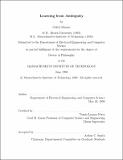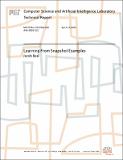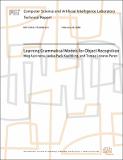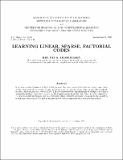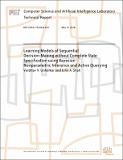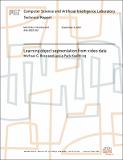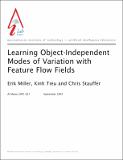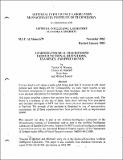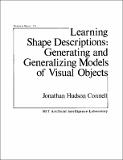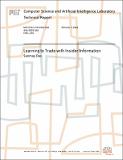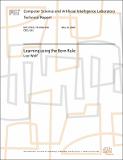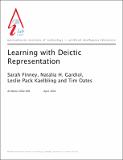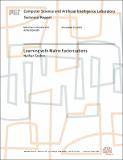Browsing Computer Science and Artificial Intelligence Lab (CSAIL) by Title
Now showing items 1817-1836 of 3804
-
Learning from Ambiguity
(1998-12-01)There are many learning problems for which the examples given by the teacher are ambiguously labeled. In this thesis, we will examine one framework of learning from ambiguous examples known as Multiple-Instance learning. ... -
Learning from Incomplete Data
(1995-01-24)Real-world learning tasks often involve high-dimensional data sets with complex patterns of missing features. In this paper we review the problem of learning from incomplete data from two statistical perspectives---the ... -
Learning From Snapshot Examples
(2005-04-13)Examples are a powerful tool for teaching both humans and computers.In order to learn from examples, however, a student must first extractthe examples from its stream of perception. Snapshot learning is ageneral approach ... -
Learning Generic Invariances in Object Recognition: Translation and Scale
(2010-12-30)Invariance to various transformations is key to object recognition but existing definitions of invariance are somewhat confusing while discussions of invariance are often confused. In this report, we provide an operational ... -
Learning Grammatical Models for Object Recognition
(2008-02-25)Many object recognition systems are limited by their inability to share common parts or structure among related object classes. This capability is desirable because it allows information about parts and relationships in ... -
Learning Linear, Sparse, Factorial Codes
(1996-12-01)In previous work (Olshausen & Field 1996), an algorithm was described for learning linear sparse codes which, when trained on natural images, produces a set of basis functions that are spatially localized, oriented, ... -
Learning Models of Sequential Decision-Making without Complete State Specification using Bayesian Nonparametric Inference and Active Querying
(2018-05-17)Learning models of decision-making behavior during sequential tasks is useful across a variety of applications, including human-machine interaction. In this paper, we present an approach to learning such models within ... -
Learning New Principles from Precedents and Exercises: The Details
(1981-11-01)Much Learning is done by way of studying precedents and exercises. A teacher supplies a story, gives a problem, and expects a student both to solve a problem and to discover a principle. The student must find the ... -
Learning object segmentation from video data
(2003-09-08)This memo describes the initial results of a project to create a self-supervised algorithm for learning object segmentation from video data. Developmental psychology and computational experience have demonstrated that the ... -
Learning object segmentation from video data
(2003-09-08)This memo describes the initial results of a project to create aself-supervised algorithm for learning object segmentation from videodata. Developmental psychology and computational experience havedemonstrated that the ... -
Learning Object-Independent Modes of Variation with Feature Flow Fields
(2001-09-01)We present a unifying framework in which "object-independent" modes of variation are learned from continuous-time data such as video sequences. These modes of variation can be used as "generators" to produce a manifold of ... -
Learning Physical Descriptions from Functional Definitions, Examples, and Precedents
(1982-11-01)It is too hard to tell vision systems what things look like. It is easier to talk about purpose and what things are for. Consequently, we want vision systems to use functional descriptions to identify things when ... -
Learning Semantic Scene Models by Trajectory Analysis
(2006-02-10)In this paper, we describe an unsupervised learning framework to segment a scene into semantic regions and to build semantic scene models from long-term observations of moving objects in the scene. First, we introduce two ... -
Learning Shape Descriptions: Generating and Generalizing Models of Visual Objects
(1985-09-01)We present the results of an implemented system for learning structural prototypes from grey-scale images. We show how to divide an object into subparts and how to encode the properties of these subparts and the relations ... -
Learning Solutions of Similar Linear Programming Problems using Boosting Trees
(2010-09-18)In many optimization problems, similar linear programming (LP) problems occur in the nodes of the branch and bound trees that are used to solve integer (mixed or pure, deterministic or stochastic) programming problems. ... -
Learning Structural Descriptions from Examples
(1970-09-01)The research here described centers on how a machine can recognize concepts and learn concepts to be recognized. Explanations are found in computer programs that build and manipulate abstract descriptions of scenes ... -
Learning to Trade with Insider Information
(2005-10-07)This paper introduces algorithms for learning how to trade usinginsider (superior) information in Kyle's model of financial markets.Prior results in finance theory relied on the insider having perfectknowledge of the ... -
Learning using the Born Rule
(2006-05-16)In Quantum Mechanics the transition from a deterministic descriptionto a probabilistic one is done using a simple rule termed the Bornrule. This rule states that the probability of an outcome ($a$)given a state ($\Psi$) ... -
Learning with Deictic Representation
(2002-04-10)Most reinforcement learning methods operate on propositional representations of the world state. Such representations are often intractably large and generalize poorly. Using a deictic representation is believed to be ... -
Learning with Matrix Factorizations
(2004-11-22)Matrices that can be factored into a product of two simpler matricescan serve as a useful and often natural model in the analysis oftabulated or high-dimensional data. Models based on matrixfactorization (Factor Analysis, ...

